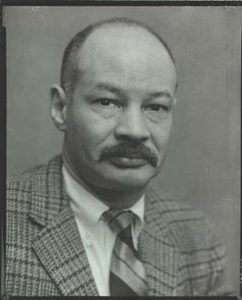
Samuel Felrath Hines Jr.
*Samuel Felrath Hines Jr. was born on this date in 1913. He was a Black visual artist and art conservator.
Born in Indianapolis, Indiana, Hines began studying art in 1926 after receiving a scholarship for youth classes at the John Herron School of Art Saturday School. After graduating high school in 1931, Hines worked for the Civilian Conservation Corps and later as a railroad dining car waiter for the Chicago Northwestern Railroad.
In 1945, he began formal art training at the Art Institute of Chicago. After deciding to concentrate on design, Hines moved to New York City, where he worked as a fashion designer and studied at New York University and the Pratt Institute. In 1963, Hines joined a club of sixteen African American artists called Spiral, formed by Romare Bearden. Spiral was a loosely structured group of black artists, ranging in age from twenty-eight to sixty-five and in style from minimalism to realism, who sponsored an exhibit of black and white artwork for symbolic reasons.
Despite his involvement with the group, Hines wanted his imagery to remain universal and not to be seen as having relevance exclusively to black social causes or African Americans. As a result, he refused to participate in the Whitney Museum of Art's landmark exhibition Contemporary Black Artists in America. His work has been associated with the De Stijl movement, often containing strong design elements inspired by Cubism and the simplicity of Piet Mondrian. His work moved from semi-abstract landscapes to geometric abstracts in the 1940s and 1950s. As Hines became more influenced by American modernists, such as Stuart Davis, Ad Reinhardt, Josef Albers, Ellsworth Kelly, and Barnett Newman, he began eliminating lines from his compositions, focusing instead on simple shapes and a restrained color palette.
His works include several collections, including the Smithsonian American Art Museum. Hines' pieces in the Smithsonian include: "Yellow and Gray," 1976, oil on linen (Gift of Barbara Fiedler Gallery, 1978.128); "Red Stripe with Green Background," 1986 oil on linen (Gift of Dorothy C Fisher, 2011.25.2); Abstract landscape, oil on linen, (Gift of Dorothy C. Fisher, 2011.46); and "Radiant," 1983, oil on linen, (Gift of Dorothy C. Fisher, 2011.46). By focusing on the non-representational subject matter and harmoniously balanced shapes and colors, Hines hoped to create works that held a conceptual meaning. He remarked, "An artist's work is to rearrange everyday phenomena to enlarge our perceptions of who we are and what goes on about us."
Hines intended for his imagery to be absorbed visually, mentally, and spiritually by everyone, regardless of gender, ethnicity, or race. Samuel Felrath Hines Jr. served as a conservator at several institutions, including the Hirshhorn Museum and Sculpture Garden in Washington, D.C. His paintings are in the Smithsonian American Art Museum collection. He died on October 3, 1993.